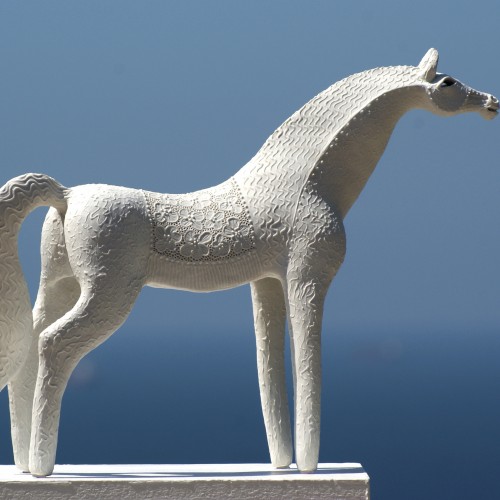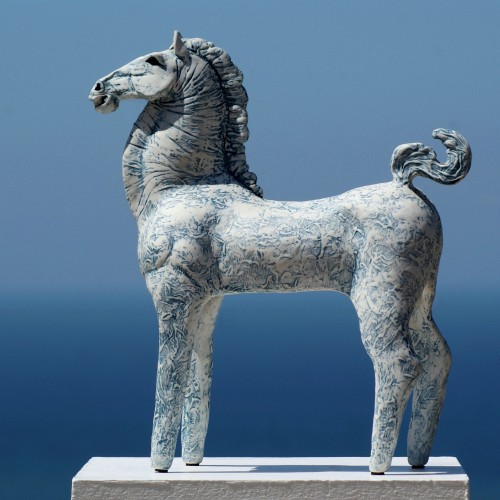Pessoa Rein~ Georgina Roberts
A WORD OF CAUTION!
As helpful as gadgets may be, there is no replacement for good schooling and conditioning. Both horses and riders ultimately need to learn how to balance themselves, develop correct muscles for sustained quality, with the rider developing accurate sensitive aids. Artificial aids can assist where there is a fundamental problem and the rider is less than experienced, helping to speed this process up by allowing both parties to get the correct feel for such work. Never assume that your groom knows how to use a specific gadget – always be educated and supervise their use.
HOW DOES IT WORK
The Pessoa Rein is the only full-body gadget, i.e. does not focus solely on the neck and head position. It cannot be used while riding, but is highly effective on the lunge. It works by teaching the horse body awareness, connection from back to front, suppleness, lightness, and to push and engage the hindleg.
WHAT HORSE WOULD BENEFIT FROM IT
It is particularly effective for horses that struggle to work through and over the back, whilst staying light in the contact. Try imagine it as teaching the horse to be “contained” in a forward bubble of movement; the second the horse leans on the bit, it will literally pull its own hindquarter further under itself. If it pushes out instead of under with the hindleg, it will immediately feel the light pressure of the rope around the hindquarter; it will also pull slightly on the bit, which is why it is important to instill the forwardness from the ground, that they never learn to correct “backwards”. It one of the best aids to use for regular lunging, and once the handler knows how to fit it very little adjusting is needed in a session – all that the handler needs be responsible for is maintaining the ratio of balance and forward tempo, and knowing which rope goes where!
HOW TO FIT IT
There are several different fittings for the Pessoa, depending on the horse’s level of training. By far the most common way for attachment is pictured: above the hock, clipped midway on the surcingle, through the bit rings, ending between the front legs. This encourages the horse to work rounder and lower, stretching the topline to encourage the “rugby ball” shape. With a more experienced and balanced horse, they can warm up like this and then have the end clips moved up to the top of the surcingle to simulate the position of the riders hands, encouraging the horse to work in a slightly more uphill frame through the wither, while still in self-carriage and pushing from behind.
WHAT TO BE CAUTIOUS OF
The feeling of containment, whilst one that we encourage more and more throughout a horse’s life, is initially a very claustrophobic one for a flight animal. Too tight, and the horse may panic and throw itself over. Too loose, and the dangly ropes are not only ineffective but a tangling risk.
Horses can learn to lean quite comfortably on themselves and may need to be pushed forward more to lighten in front. On the other side, a horse that is particularly shy in the contact will tuck his nose in and suck away from the bit, not pushing forward, as he might not like the lack of steady pressure on the mouth.
The Pessoa, being on a pulley system, can also slide a little to the horse’s favourite side. It may need to be shifted back into the correct place when changing rein, and if the horse consistently shifts it due to severe one-sidedness, then long-reining (where the handler can control the straightness directly) will be a better option.
Horses also commonly kick out at the feeling of something toughing their hocks – try not to panic, but gently push them forward. If they are reluctant to go forward, make sure that it is not too tight to begin with that they feel they can “go somewhere”, and try maintain the rhythm until the horse relaxes into the frame. If the horse wants to shoot forward away from the back rope try keeping his head bent slightly in towards you and not letting the circle get too big. If the horse is particularly sensitive about his hindquarters you can desensitise him first by lunging with a crepe bandage tied from the girth, around the hindquarters, and back to the girth. This arrangement will not change pressure with the frame, thus allowing them to get comfortable and confident working like that before upgrading to the Pessoa.
HANDY TIPS
Colour code the ropes in the beginning if you have trouble remembering which goes where! Also remember to only put it on once in the lunging arena in case the horse does panic. The ends of the ropes can tend to fray, so to ensure longevity tape them. Make sure the pulleys turn easily and don’t jam, and once you and your horse are confident, don’t be shy to experiment with other settings: it’s a great way to develop an eye for how small changes can alter the biomechanics of your horse.







